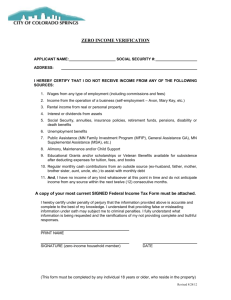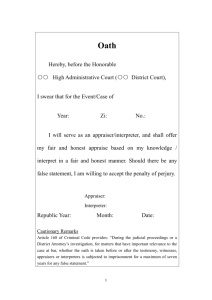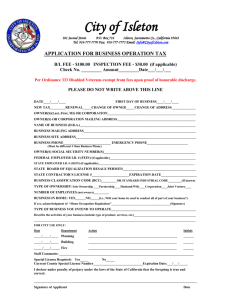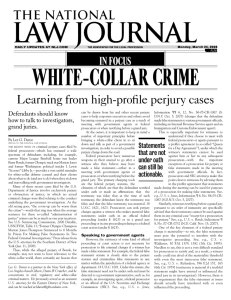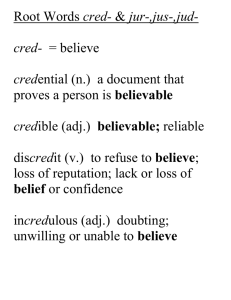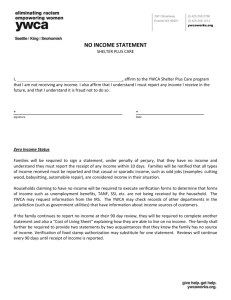Civil actions against witnesses who have committed perjury
advertisement
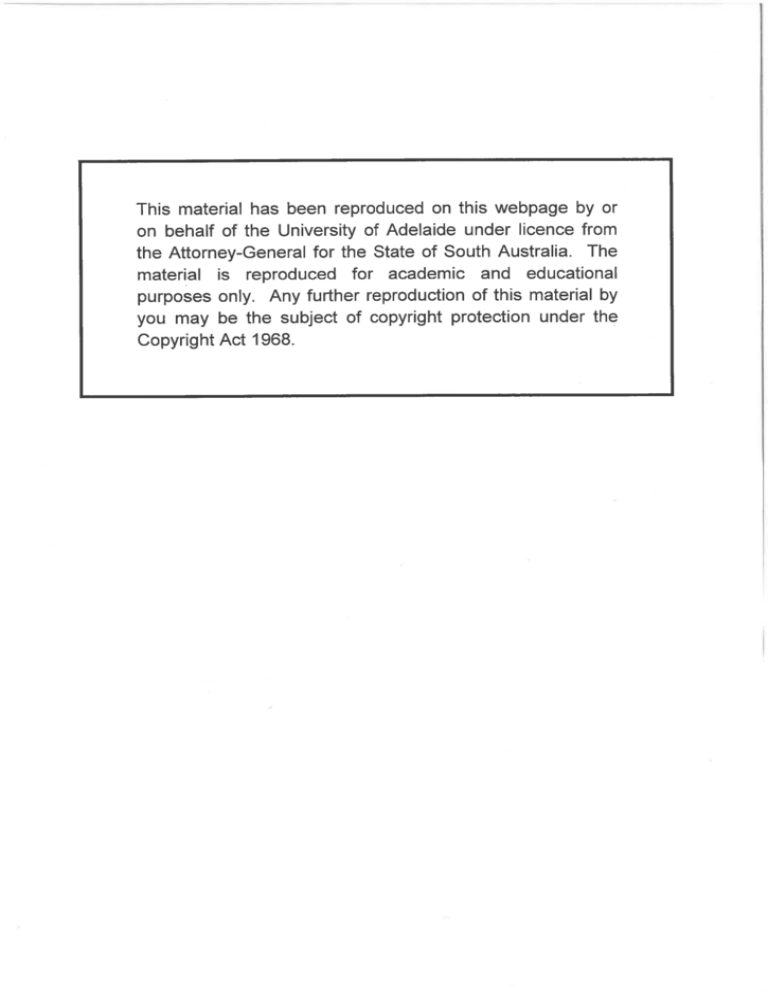
SOUTH &W AUSTRALIA :\' .%. TWEN TY-THIRD REPORT of the LAW REFORM COMMITTEE SOUTH AUSTRALIA to THE ATTORNEY-GENERAL REGARDIKG CIVIL ACTIONS AGAINST WITNESSES WHO HAVE COMMITTED PERJURY The Law Reform Committee of South Australia was established by Proclamation which appeared in the South Australiun Government Gazette of 19th September, 1968. The present members are: THE HONOURABLE MR. JUSTICE ZELLING, C.B.E., Chairman. B. R. COX,Q.C., S.-G. R. G. MATHESON. K. P. LYNCH. J. F. KEELER. The Secretary of the Committee is Miss J. L. Hill, c/o Supreme Court, Victoria Square, Adelaide, South Australia. TWENTY-THIRD REPORT OF THE LAW REFORM COMMITTEE OF SOUTH AUSTRALIA REGARDING CIVIL ACTIONS AGAINST WITNESSES WHO HAVE COMMIlTED PERJURY To: The Honourable L. J. King, Q.C., M.P., Attorney-General for South Australia. Sir, You have referred to us for consideration the question whether an action should lie at law against a person who has committed perjury as a witness in a civil action at the suit of a party to that action who has suffered damage (including in that expression liability for costs) as a result of the perjury. Most forms of perjury also constitute contempts of court. Accordingly in a blatant case a Judge may well deal with the perjury there and then as a contempt. If he did so there v;ouId be no prosecution for perjury because of the provisions of Section 50 of the Acts Interpretation Act, 1915-1957 which in effect pro-Ade that a man is not to be punished twice for the same offence. Hereafter in this paper wherever a conviction for perjury is referred to, it includes a conviction for contempt based upon the commission of perjury. A consistent line of cases dating from Queen Elizabeth's reign has established that there is at present no civil claim for damages against a witness who commits perjury. In these cases the desire not to deter witnesses from freely testifying has prevailed over the risk of false and frequently damaging testimony. Criminal liability for perjury by witnesses (as opposed to the false verdict of a jury, which was governed by the writ of attaint) was established in Star Chamber practice and consolidated by statute. The most comprehensive,statute to define and punish perjury in witnesses rather than jurors was passed in 1562-1563 (5 Eliz. I c. 9), and its tendency to discourage potential witnesses from giving evidence was countered by the introduction by the Chancery of the writ of subpoena. Ever since that time the courts have been sensitive to the effect on witnesses of making their testimony subject to criminal liability. Hence they refused to entertain any action in respect of perjury involving pemding proceedings (Lord Beauchamp v. Sir R. Croft 1569 Dyer 285a) and, initially hesitated to deal with witnesses for the Crom, or witnesses at all in cases where the verdict had passed according to the evidence. Although these last two barriers have been lifted, the courts remain adamant that no action on the case lies in the case of perjury (or, in fact, in respect of any other offence committed by a witness in the box). Coke strongly maintained that perjury was an offence at common law, and that an action on the case did lie against voluntary witnesses:Rowland ap. Elizn (3 Co. Inst. 163) and Jerorn & Knights case in 1588 (1 Leonard 107). However, the case of Damport v. Sympson (Cro. Eliz. 520) in 1596 has prevailed as authority to the contrary without reference to Coke's arguments. There it was held that no action on the case for perjury could lie because there was no common 3 law offence of perjury, only a discretion to punish in the Star Chamber, and that the offence was governed by statute only, which did not cover civil claims. In any event, the Court found no precedent for such an action, and deplored the possibility that it could be called upon to question the minds of the jury in determining to what extent the;: found the testimony credible, or influential upon their verdict. Another factor that weighed heavily in the judgments was that the defendant could be twice punished for the same offence, and that the concept of finality of judgment would be destroyed. The decision of Harding v. Bourdman (1617) Hutton 11 is consistent with Damport v. Synipson. In Eyres v. Sedgewicke (1620) Cro. Jac. 601, and in Ashhy v. White (1703) 25 Ruling C 52, it was asserted that perjury u-as far too great an evil to be punished merely by civil action: it was in the public interest that the Crown should have sole licence to punish. In few subsequent cases has the policy of protecting witnesses from civil proceedings been questioned in any constructive way, and American decisions have invariably supported the cries of "public policy" and "no precedent". In Dunlap v. Glidden (1850) 31 Me. 435, 52 Am. Dec. 625, it was said that: "If the judgment was obtained, as is contended, by fraud and perjury, the plaintiff has ample remedy by law. The Court which rendered the judgment, upon proof of these allegations, would be bound to grant a new trial, so that upon a further investigation justice might be done. The witnesses, if guilty, might be indicted for perjury, and so might all those be indicted who had unlawfully conspired together to deprive the plaintiff of his rights, and their conviction would afford the most convincing evidence that a review of the actions should take place." The Australian procedural ramifications of such redress are discussed by Mr. Justice Gowans in his article Perjury and its Civil Conseqfiences in 15 A.L.J. 106. American Courts in Curtis v. Fairbanks (1846) 16 N.H. 542, Gunsman v. Hearsey (1876) 28 La. Ann. 709, G d e t t e v. Gaskill ( 1 909) 151 N.C. 52, and Cunningham v. Brown (1846) 18 Vt. 123, 46 Am. Dec. 140, refused to entertain any action which might call into question the merits of a previous suit. In fact, in Schultz V. Schultz (1894) 136 Ind. 323, 43 Am. St. Rep. 320, it was held that estoppel by judgment was a complete defence to such an action. This however could not possibly be right as the contemplated action would be between one party to the previous action and another person who was neither party nor privy to that action. The most common refrain throughout the cases is however, that:- "A litigant, smarting under the loss of his suit, could subject witnesses to the annoyance and expenses of litigation at will" (Godette v. Gaskill, supra). 4 I 1 I 'I Defamation cases have become allied with perjury cases to support the general rule:-see Dawkins v. Lord Rokeby (1873) L.R. 8 Q.B. 255, Watson v. McEwan (1905) A.C. 480 and Seaman v. Netherclift (1876) 1 C.P.D. 540. The 1940 decision of the High Court of Australia of Cabassi v. Vilu 64 C.L.R. 130 seems to deny any cause of action for conspiracy to give false evidence although it must be said that the use of the civil action for conspiracy in other spheres has tended to expand in recent years. The decision in Hargreuves v. Brefherton (1958) 3 W.L.R. 463, seems generally to sum up the present state of the law regarding civil actions for perjury. Hence more subtle ways have been sought to side-step the implications of the rule relating to immunity of witnesses but so far without success. They revolve about the action of conspiracy and the usually related, action of malicious prosecution. In a statute of 1304 (33 Edw. I de Conspiratoribus) the definition of conspiracy ran thus : "Conspirators be they that do confeder or bind themselves by oath, covenant or other alliance that everyme of them shall aid and support the enterprise of each other falsely and maliciously to indict, or cause to be indicted, or falsely to acquit people, or falsely to move or maintain pleas: . . . and such as retain men in the country with liveries and fees for to maintain their malicious enterprises and to suppress the truth." In effect towards the end of the fifteenth century the writ came to lie exclusively for a conspiracy to indict or appeal a man of felony. The action on the case became the most popular medium for an action for fraudulent use of the machinery of the Courts, and the cause of action became the damage suffered rather than the act of conspiracy. In recent times actions for malicious prosecution have incorporated false testimony in their cause for complaint, and have been successful: The case of Roy v. Prior (1970) 2 All E.R.729, states: "The existence of the well-settled rule that no action would lie against a witness for words spoken in giving evidence in Court, even if the evidence was false and malicious, did not mean that an action brought in respect of an alleged abuse of process of the court must be defeated if one step in the abuse of process involved or necessitated the giving of evidence". This decision is supported by the previous decisions (cited in that case) of: Daniels v. Fielding (1846) 16 M.& W.200, Revis v. Smith (1856) 18 C.B. 126, Melia v. Neate (1863) F. & F. 757, and Johnson v. Emerson (1871) L. R. 6 Exch. 329. The American case of Verplanck v. Van Buren (1879) 76 N.Y. 247, had already stated that: "Nor does the fact that the combination and fraud were brought to a successful end by false testimony produced upon the trial make the case obnoxious to the rule that there can be no civil action for perjury or subornation of perjury. The false testimony is not the sole moving factor in the cause of action. The fraudulent purpose or intent, formed before the accounting and trial, the fraudulent concoction of the unreal contracts with Kendall, the 5 false entries in the books of account, are the chief basis of the cause of action. The actions of the defendants upon the trial are but the part of an entire transaction." In Rice v. Coolidge (Mass) 23 Am. Rep. 279, the Court acknowledged that "if the acts charged when done by one alone were not actionable, they were not made so by being done by several in pursuance of a conspiracy," but it went further to say "that the perjured witness and the one who suborns him are joint tort-feasors, acting in conspiracy or combination to injure the party defamed, and that the fact that one of them is protected from a civil suit by personal privilege does not exempt the other tort-feasor from such suit." Such novel approaches have little chance of eroding the general rule. Several commentators are clearly in favour of statutory alteration of the old law :-See C. Howard: "Good Look Backwards", Modern Law Review Vol. 21 680 (1958); "Hargreaves v. Bretherton-tort-perjury-lack of remedy: " Osgoode Hall Law Journal Vol. 2, 158 (1960) ; "No Damages for Perjury", The Solicitors' Journal Vol. 102. 591 (April 1958) ; "The Problem of Successful Perjury", The Scdicitors' Journal Vol. 78, 428 (1934); Alec Samuels: "A Remedy for the Victim of Perjury", The Solicitors' Journal Vol. 114, 677 (1970). An article by D. E. Murray in the Ohio State Law Journal Vol. 27, 102 entitled "Convictions obtained by perjured testimony: a comparative view", indicates that few of the major legal systems do in fact entertain any sort of civil action for perjury. While the Committee recognizes that in some circumstances the policy that cases should not be able to be relitigated as a result of perjury actions is a valid one, the Committee thinks that it is more important that blatant frauds should not go unredressed. We recommend that the law should be amended to provide that a civil action should lie against a witness who has committed perjury in an action, at the suit of a person who has suffered damage (including in that expression liability for costs) as a result of the perjury in the following circumstances :1. The evidence given by the perjured witness must have been material evidence in the first action. 2. The defendant must either have been convicted of perjury in relation to the first action or it must be proved that the AttorneyGeneral has decided not to prosecute. The latter of these alternatives of course simply relates to the Crown's discretion whether or not to lay an information in any given case and not necessarily to the strength or weakness of the evidence which would prove the perjury. It is common knowledge that it is difficult to induce juries to convict even in a plain case of perjury and naturally the Crown has to take that into consideration (along with other matters) in deciding whether or not to prosecute. Where the defendant has not been convicted the plaintiff's case should be supported by corroborating evidence. 3. In order to get over any defence based on res judicata the proposed Statute should include a clause that this cause of action shall not be defeated by a defence based on the maxim res judicata accipitur pro veritate. 4. It is sufficient that but for the perjured evidence the plaintiff in the second action might ha\-e succeeded in part or might have succeeded in diminishing the verdict otherwise given in the first action, e.g. by proving contributory negligence. We have not made any recommendation whether it should be a statutory requirement that perjury in a civil action must be proved by the evidence of two witnesses as in a criminal case. We rather think that this requirement should mot be necessary but we draw the matter to your attention for consideration. We have also not considered the question whether an action should lie at the suit of the Crown arising out of perjury committed in criminal or penal proceedings as we regard this as a matter of policy for the Government and as being outside the terms of our reference. We have the honour to be B. R. Cox Law Reform Committee of South Australia.

